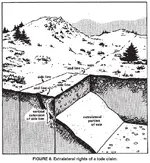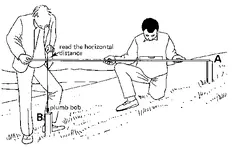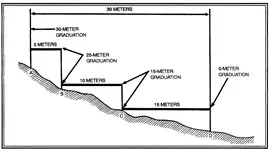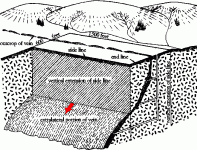Regarding measurements, all slope distances are reduced to horizontal distances when describing land boundaries.
A long time ago, when I first began land surveying, I stretched many a "chain" to measure boundary lines. Many things were taken into consideration with chain measurements. The chains were typically 300' long and each chain, while very high quality, had stretch characteristics unique to it, which were accounted for.
Measurements were taken with the chain clear of the ground and any vegetation along the traverse line. Generally a chainman would drag the chain out slightly behind the brushers clearing the line, also helping with the clearing and making sure the back path to the instrument at the last traverse station is "clear".
It was very important to have a smart lead chainman. Upon approaching 300' from the last station or a break in the terrain, a suitable location, close to "line", was selected for the next station. This location would need to be on solid ground, suitable for setting up the tripod and theodolite and advantageous to seeing a "long" course ahead to the next possible station.
Once the new hub (station) was set, the chain was cleared from any brush, limbs, etc by firm but at the same time gentle whipping up and down. When cleared, the instrument man would take a truly sturdy stance by the "gun" (theodolite), raising his end of the chain to an even one foot mark at a vertical and horizontal mark at an axis of the scope which was pointed at the next station.
At the other end, the lead chainman would begin to take the slack out of the chain in a steady manner of increasing effort while suspending a plumb bob and string over the chain. At this end of the chain, beyond the zero mark, is another foot which has raised increments divided into tenths and hundredths of a foot.
The chainman increases the pull on the chain until the instrument man, holding on an even foot at the other end, hollers "mark" or whatever they are used to. The chainman is sliding the plumb bob and string along this extra foot to exactly over the hub and tack, hollering back when he has a good set (measure). The chainman immediately notes the value of this additional distance and the instrument man notes his foot mark. The two combine for a total distance to this course. This distance was then, later in camp or at the office, reduced to horizontal distance along with the workup of the horizontal angles of the traverse. When I first started surveying we didn't have calculators and computers. We used angle reduction tables in book form to reduce raw field angles. All measurements were recorded if a waterproof field book. It was a cardinal sin to loose one of these field books. Really!!!
Depending on the order (accuracy required) of the survey, more elements are incorporated. Spring balance on the ends of the chain, temperature and atmospheric pressure correction etc.
I know this is kind of a long winded post about a basic question, but surveying in general, and the history of our Public Land Survey System, is really fascinating to anyone interested in this sort of study. The PLSS was a truly unique and well thought out government operation. There was great effort and honesty as well as great frauds in the surveying of our western lands.
Mike








